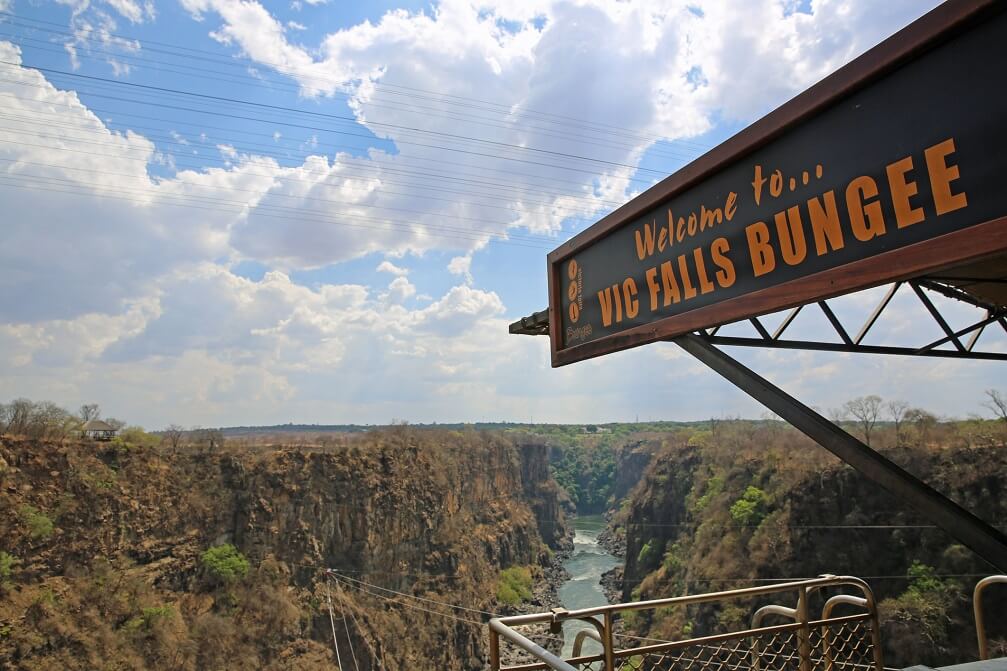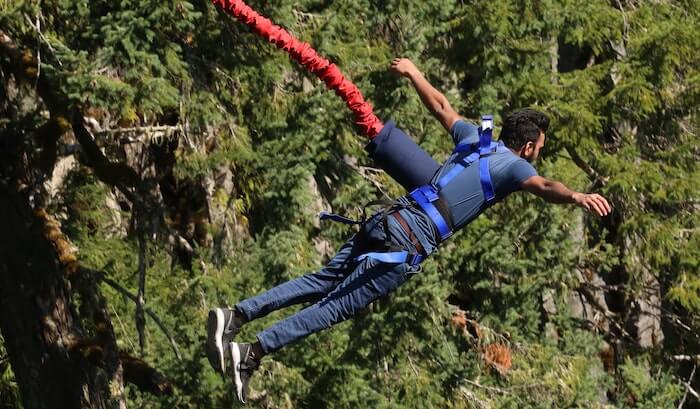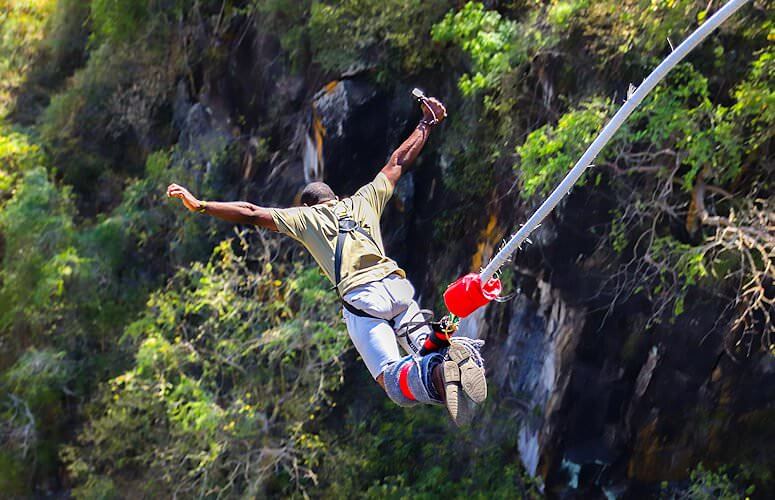Feel every cell in your body turn electric with one of the most adrenaline-fueled experiences on the planet – Bungee Jumping at Victoria Falls!
As your heart pounds uncontrollably and you’re ready to let gravity take over, have you wondered what goes into preparing for this ultimate thrill? Or how to maximise this exhilarating experience afterwards?
Before bungee jumping, assess your own health and determine if you’re medically fit. Make sure to book your jump in advance and avoid overthinking the jump. Wear comfortable clothes, and eat a small portion a couple of hours prior. After the jump, it’s recommended to drink plenty of water, stretch your muscles, and take time to reflect on the experience. If you feel any pain or discomfort afterward, seek medical attention immediately.
In this thrilling blog post, we will plunge headfirst into the essential steps both before and after bungee jumping that could make all the difference between an ordinary jump and an extraordinary leap of faith! Get ready to conquer those intense jitters and immerse yourself in one of life’s truly phenomenal adventures like never before.
Pre-Jump Safety Measures
Bungee jumping, an exhilarating adventure sport that tests one’s fear of heights, requires careful preparation to ensure a safe and memorable experience. Before taking the leap, it is essential to understand and follow pre-jump safety measures. These measures are designed to minimise risks and ensure optimal conditions for your jump.
Firstly, it is crucial to choose a reputable bungee jump operator and location to ensure safety and peace of mind. Research the company’s track record and inquire about the qualifications of the trainers and instructors involved. This information will help you gauge their expertise and professionalism.
Next, assess your own fitness level and any pre-existing health conditions that may affect your ability to bungee jump. Certain medical conditions, such as ankle or leg injuries, back or spinal injuries, and heart problems, may prohibit you from participating in this adventure sport. It is essential to consult with a healthcare professional beforehand to evaluate whether you are medically fit for bungee jumping.
In addition to physical fitness, mental preparedness plays a significant role in ensuring a smooth jump. Overcome any fear or anxiety by visualising a successful jump and focusing on positive thoughts. Avoid overthinking the jump and trust in the well-trained staff who will guide you through the process.
Maintaining proper nutrition also contributes to a successful bungee jumping experience. Avoid overeating before the jump to prevent potential discomfort or vomiting during the adrenaline rush. Instead, opt for a small portion of food a couple of hours before the jump, ensuring that you have enough energy without feeling too full.
Remember, safety should always be the top priority when engaging in any adventure sport. Adhering to pre-jump safety measures ensures a smooth and enjoyable bungee jumping experience.
- According to a study in the British Journal of Sports Medicine, only approximately 0.2% of all bungee jumps worldwide result in injury, indicating the importance of safety procedures.
- The same study found that a good proportion of these accidents can be attributed to human error rather than equipment failure, underlining the necessity of instruction from well-trained professionals.
- A report published in Wilderness & Environmental Medicine stated that adrenaline levels can increase up to 200% during a bungee jump, which emphasises the need for appropriate fitness conditions and post-jump rest.
Choosing a Reputable Bungee Jumping Location
When it comes to bungee jumping, one of the most critical factors in ensuring a safe and memorable experience is choosing the right location. Selecting a reputable bungee jumping location provides a calming environment and guarantees suitable infrastructure for a successful jump.
A reputable location typically offers scenic beauty and awe-inspiring landscapes, adding to the overall thrill of the adventure. Imagine taking that leap of faith while surrounded by picturesque mountains or plunging towards glistening waters. Such surroundings can enhance your overall experience and create lasting memories.

We would always recommend Victoria Falls, Zimbabwe, as it is one of the Seven Natural Wonders of the World, but we are biased!
Beyond aesthetics, consider the reputation and track record of the bungee jumping site. Look for locations with well-trained staff, certified instructors, and rigorous safety protocols in place. Investing in research will give you insight into their expertise, commitment to safety, and customer satisfaction.
Accessibility is another key aspect to consider when choosing a bungee jumping location. Opt for a location that is convenient to reach, whether by car or public transportation. This ensures minimum hassle and allows you to focus on enjoying the adrenaline rush rather than worrying about logistics.
Additionally, inquire about the equipment used for jumps at each location. Advanced technical equipment contributes significantly to ensuring safety during the jump. Ensure that the bungee cords or ropes used are regularly inspected and replaced as per industry standards.
Lastly, read reviews and seek recommendations from others who have experienced bungee jumping at various locations. Personal anecdotes and testimonials can provide valuable insights into what to expect from different bungee sites. Consider factors such as staff friendliness, customer service, and overall professionalism when making your decision.
By taking the time to choose a reputable bungee jumping location, you can have peace of mind knowing that experienced professionals are guiding your jump and maintaining the highest standards of safety.
Fitness and Health Evaluation
Before taking the leap of faith into the thrilling world of bungee jumping, it is essential to undergo a fitness and health evaluation. Bungee jumping involves an intense physical activity that can put stress on your body, especially as it entails free-falling from a height and experiencing sudden deceleration. By undergoing a comprehensive evaluation, you can ensure that you are physically fit and capable of handling the demands of this extreme adventure sport.

During the fitness and health evaluation, certain factors will be assessed to determine your eligibility for bungee jumping. One critical aspect is your overall physical fitness level. This includes evaluating factors such as cardiovascular health, muscular strength, and flexibility. Regular exercise routines involving cardiovascular activities such as running or cycling can help strengthen your heart and lungs, making them better prepared for the increased demands placed on them during the jump.
Additionally, any existing injuries or medical conditions should be taken into account during the evaluation process. Certain conditions, such as ankle or leg injuries, back or spinal injuries, and heart problems, may prohibit you from participating in a bungee jump due to safety concerns. It is crucial to disclose any pre-existing medical conditions to ensure that both you and the jump operators are aware of potential risks.
Imagine you have a history of back problems that have caused occasional discomfort in the past. Before committing to a bungee jump, consulting with a healthcare professional or therapist would be highly recommended. They can provide valuable insights into whether your back is strong enough to withstand the forces exerted during the jump. By seeking expert advice, you can make an informed decision about participating in this exhilarating activity.
A fitness and health evaluation for bungee jumping may involve assessing:
- Cardiovascular health
- Muscular strength
- Flexibility
- Any pre-existing injuries or conditions
Remember, your safety should always come first when considering bungee jumping. It is essential to evaluate your physical fitness and consult with healthcare professionals to ensure you are medically fit for this adventure.
Having covered the importance of a fitness and health evaluation, let’s dive into the bungee jumping experience itself and what you can expect.
The Bungee Jumping Experience
Bungee jumping is not just about conquering the fear of falling; it offers an adrenaline rush like no other. As you stand on that platform, preparing to take the leap, a mix of excitement, nervousness, and anticipation surges through your body. The build-up leading to those few seconds of free fall creates memories that will last a lifetime.
One key aspect of the bungee jumping experience is the stunning natural surroundings that often accompany jump sites. Whether perched on a towering bridge or overlooking breathtaking scenery, choosing a location that complements the thrill with beauty adds an extra dimension to the whole adventure.

Imagine standing on a bridge, harnessed and ready to jump, as the roaring rapids of a river flow beneath you. The rush of adrenaline becomes intertwined with the awe-inspiring natural beauty surrounding you. This integration of adventure and scenic wonder creates a truly immersive experience.
Throughout your experience, professional bungee jump instructors will be by your side, ensuring your safety and providing guidance every step of the way. These instructors undergo rigorous training in international standards and procedures, so you can trust them with your life as you make this thrilling leap.
Think of bungee jumping instructors as experienced mountaineering guides who help navigate treacherous terrains during challenging climbs. Their expertise provides reassurance while allowing you to fully enjoy the extraordinary journey.
The bungee jumping experience combines both mental and physical elements, allowing you to push beyond your comfort zone while feeling alive and exhilarated. It is a truly transformative adventure that stays with you forever.
Overcoming Fear and Anxiety
Bungee jumping is an adrenaline-pumping adventure sport that often requires conquering the fear of falling from a great height. Naturally, fear and anxiety go hand in hand when facing the prospect of jumping off a platform or bridge. However, there are several strategies you can employ to overcome these emotions and fully embrace the thrill of bungee jumping.
One highly effective technique is to reframe your mindset and focus on the excitement rather than the fear. Instead of dwelling on negative thoughts, visualise yourself successfully completing the jump and experiencing an incredible rush of adrenaline. This positive visualisation can help shift your mindset from fearful to empowered.
Consider the experience of Jessica, who had always been terrified of heights. Before her first bungee jump, she focused on images of herself triumphantly leaping off the platform with a huge smile on her face. By repeatedly visualising this scenario, she was able to rewire her brain’s response to fear and transform it into excitement.
Remember, fear is just a barrier waiting to be broken down. Acknowledge your fears but don’t let them paralyse you; instead, use them as fuel to conquer new heights.
Another effective strategy for overcoming fear and anxiety is seeking support from friends or loved ones who can accompany you on the jump. Doing a tandem bungee jump not only provides emotional support but also helps to normalise the experience and make it less daunting. Sharing the thrill with someone you trust can alleviate fears and create lasting memories.
While conquering fear and anxiety is essential for a successful bungee jump, it’s equally important to take care of your physical well-being after you’ve made the leap.
After the Jump: Physical Care
After the exhilarating freefall and rebound, it’s crucial to prioritise your physical well-being post-jump. Here are some key considerations for taking care of your body and ensuring a smooth recovery:
Let’s take a look at Jake’s experience. After his bungee jump, he experienced a rush of adrenaline and excitement. He recognised the need to give his body time to recover from the intense physical experience, so he made sure to hydrate himself with water and electrolyte-rich drinks. He also took some time to rest and stretch to alleviate any muscle soreness.
Your body has just gone through an extreme physical experience, so it’s important to provide it with the care and attention it deserves.
First and foremost, ensure you stay hydrated by drinking plenty of fluids. Bungee jumping can be physically demanding and may cause excessive sweating, so replenishing lost fluids is crucial for maintaining proper bodily functions.

Next, prioritise rest and relaxation. Allow your body the time it needs to recover from the physiological stress of the jump. Take breaks when needed, stretch your muscles gently to prevent stiffness, and listen to your body’s cues for rest or movement.
In addition to hydration and rest, it’s essential to pay attention to any potential injuries or discomfort that may have arisen during the jump.
Your safety should always be a top priority. Take heed of any signals your body may be sending you post-jump.
Check for any signs of injury such as bruises, strains, or sprains. If you notice any pain or discomfort that persists or worsens, seek medical attention immediately. It’s always better to err on the side of caution when it comes to your health.
What to Wear and Eat Prior to Jumping
When it comes to what to wear for a bungee jump, comfort is key. Opt for flexible and comfortable clothes that allow freedom of movement. Singlets, t-shirts, shorts, or trousers are ideal choices. Avoid wearing skirts, dresses, or high heels as they might restrict your movements or pose safety risks during the jump.
It is also crucial to remove any loose items or accessories before jumping. Take off glasses, contact lenses, watches, and jewelry to prevent them from getting lost or damaged during the jump. Tie back or secure long hair properly to keep it away from the cords and avoid potential entanglement.
Imagine being all set for a thrilling jump but suddenly realizing your loose hair is caught in the cords! By securing your hair properly beforehand, you eliminate such unnecessary worries and ensure a smooth experience.

In terms of food consumption, it is recommended not to overeat before the jump. A heavy meal can lead to discomfort or even vomiting during the intense experience. Instead, eat a small portion a couple of hours before the jump to keep your energy levels up without feeling overly full.
Remember, preparation is key when it comes to bungee jumping. By considering these additional preparations and paying attention to what you wear and eat before taking the leap of faith, you can optimise your overall experience and create unforgettable memories that will last a lifetime.
